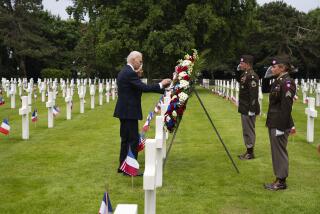ARMISTICE DAY MEMORIES MARCHING INTO HISTORY
- Share via
The siren on the old firehouse next to the drugstore used to blow every day at noon. If you stood right under you felt it was going to leave you deaf, and shake your teeth loose as well.
In the summers when we were very young, it was the subject of a dare. The small fry would run downtown to watch Chris Fogarty open the box and push the red button that set the siren going. Chris must have worked for the village; the Fire Department was volunteer then, as it still is. We would stand there, hands over our ears, screaming, “Wahoo” as loud as we could, for the odd pleasure of having our voices drowned out by the siren.
A friend of mine used to say he grew up in a part of Iowa that was so quiet you’d drive 10 miles to watch them grease a windmill. I’m not sure that even in Hammondsport, N.Y., these days you could make an event out of watching the noon siren. There is probably something good on Keuka Cable.
The siren blew early on Nov. 11 in the years I remember: at 11 a.m. when, we were taught, World War I ended. The church bells rang, too, tolling very slowly.
Laura Ide Bailey, the town librarian, put a special display in the window, books about the war, including the poetry. There was a poster, probably done by somebody up at the high school, which carried the lines “In Flanders Field the poppies grow / Between the crosses, row on row.”
Armistice Day carried fresh meaning in those days; the war was not then even 20 years in the past. The World War I veterans, in their American Legion or VFW caps or uniforms, if they could fit into them, dominated all the parades. There was no parade on Armistice Day that I recall, but an honor guard from the local Legion post, commanded by Arthur Swartwood, who ran the Gents Club barbershop, would gather at the cemetery and fire a salute.
There were still a few Spanish-American War veterans in town and, well into the ‘30s, Hammondsport boasted one last Civil War veteran. Daddy Griggs was said to have been a drummer boy and, in his 90s, nearly blind, he shuffled across town every day from his house to the post office, saying “Hey-hey” to everybody who said hello, and everybody did.
Those memories are sharp. What is harder to remember is exactly how I felt about war and death then, before all the experiences of later life crowded and colored the innocent child’s-eye view.
Yet even sorting out the adult overlay on what the boy saw and felt, it seems to me the siren produced a melancholy silence that was more than a ritual observance.
As the ‘30s went on, the sadness was already touched with foreboding. You couldn’t listen to newscaster Lowell Thomas or hear adults talk without knowing that things were getting to be a mess again.
There was undoubtedly a lot of patriotic posturing in some of the holiday observances. I wasn’t too young to catch that there was a certain amount of kidding aimed at some of the spit-and-polish veterans who had, in fact, never got east of Fort Dix, N.J., or seen the ocean.
I’m not sure when it began to be obvious that the parade hadn’t ended, and that Armistice Day covered only one war. The nearer you got to adolescence in those days, the more inevitable it came to seem that there would be further calls to duty and that you might get to march in your own parade.
So it proved for all of us who grew up with the noonday siren. I haven’t marched in any parades, and the only parts of the uniform I could still get into are the necktie and the shoes and socks.
What Armistice Day retains for me out of the past is that old, distant melancholy, now deepened by the fact that Armistice Day has become mostly a ritual observance, and not really much observed at that. It now stands as a tribute to brave men--and an ironic reference back to an innocent day when it was possible to believe that a war had ended war.
It is hard to know what to believe on Armistice Day, 1986, which now as Veterans Day honors the brave of other wars, with other memories. The present perils and horrors are unthinkable, even measured against the slaughters of 1914-18. Yet the most horrendous casualty of all is innocence, and clarity: the unambiguous distinctions between right and wrong, truth and falsehood, good and evil. Wars seemed clearer then, and so did peace.
Things were never as simple as memory makes them, yet you yearn for those days when history could still be seen as a long march, often deflected but never ultimately deterred, toward a dream of peaceful perfection, and things were as sharp and clear as a siren in the noon air.
More to Read
Sign up for Essential California
The most important California stories and recommendations in your inbox every morning.
You may occasionally receive promotional content from the Los Angeles Times.













